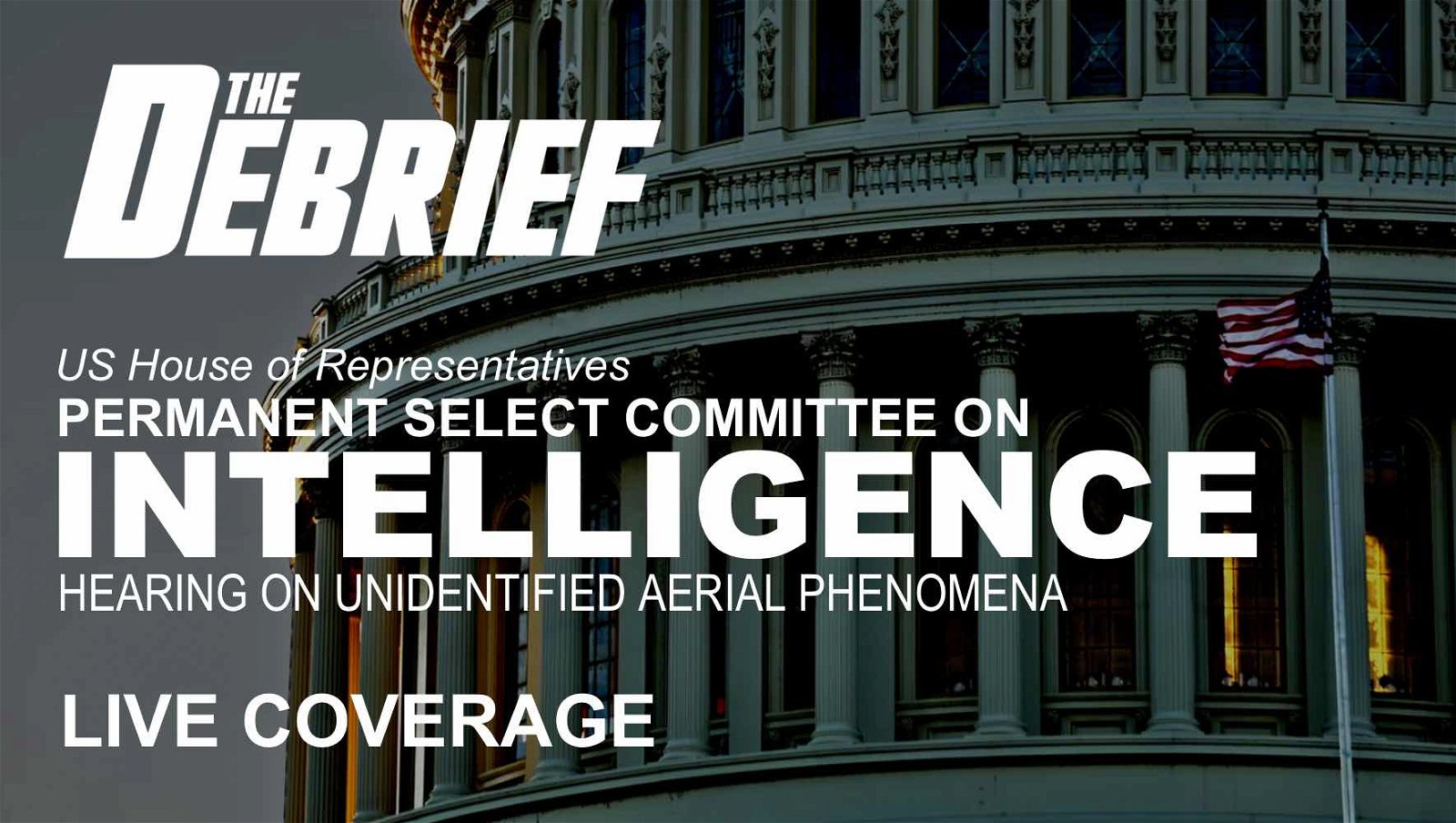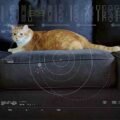Below are highlights from The Debrief ‘s live coverage of historic Congressional hearings on unidentified aerial phenomena (UAP) by the House Intelligence Counterterrorism, Counterintelligence, and Counterproliferation Subcommittee, which began at 9 AM Eastern on Tuesday, May 17, 2022.
Among the topics addressed by the House Panel were the Pentagon’s Airborne Object Identification Management and Synchronization Group (AOIMSG), along with witness testimony from Under Secretary of Defense for Intelligence & Security Ronald S. Moultrie and Deputy Director of Naval Intelligence Scott W. Bray.
Highlights from the C3 Hearing on Unidentified Aerial Phenomena


10:33 AM ET: Rep. Carson asks whether there are efforts in place to ensure that the U.S. government is not “chasing its own tail” by potentially collecting information on its own secret aircraft.
Moultrie says DOD has established relationships to help “deconflict activities we have” to prevent AOIMSG collection of data on experimental platforms produced by the U.S. Government.
“We want to ensure that we are protecting their sources and methods,” Moultrie says, while working to “deconflict” those projects and the efforts of AOIMSG.
Bray says he is “quite confident” that the explanations for most UAP do not involve such platforms.
Bray also says the UAP Task Force has a “good relationship” with the U.S. Space Force, and that the AOIMSG will continue to network with Space Force and U.S. Space Command to coordinate efforts toward the exchange of data on UAP.
Following this series of questions, the open portion of the C3 Subcommittee Hearing on Unidentified Aerial Phenomena was closed for recess, to reconvene at 12 PM ET for the classified portion of the hearing.
10:30 AM ET: Rep. Schiff asks for further clarification about UAP that appear to have emitted radio frequency energy and other evidence of a technological source.
“The biggest thing that you’re looking for there is any indication of an effort to jam whatever sensors that we may have looking at it,” Bray says.
Moultrie adds that “the fact that emanations coming off of any platform… could be radio frequency activity related to that entity transmitting out, or something transmitting to that platform.”
“That’s a part of what we’ll be looking at in the AIMSOG,” Moultrie says, noting the hope to us RF frequency detections in an effort to try to determine the nature and function of some UAP.
10:28 AM ET: Bray cites the 2004 Nimitz incident as being “unresolved.”
“We have data on that and it remains simply unresolved,” Bray says. “I can’t point to something that definitively was not manmade,” though adding that the incident remains unresolved by the DOD.
10:26 AM ET: Bray says that he is committed that material under his authority “that does not involve sources and methods, and when we can with a reasonable degree of confidence determine that it does not pose a foreign intelligence or national security threat, and it’s within my authority to do so, I commit to declassifying that.
Moultrie also adds that the intelligence community has in recent months “disclosed more information” related to UAP events “than it probably has in the last ten years,” similarly emphasizing a commitment to transparency on the UAP issue.
10.19 AM ET: Rep. Welch asks about the separation between DOD interests in UAP, and the questions about possible extraterrestrial life.
“There are elements in our government that are engaged in looking for life in other places, and they have been doing that for decades,” Moultrie says, adding that the DOD’s goal isn’t to “cover-up” anything we may find, but to understand the national security ramifications of things like weather phenomena, as well as the possibility of the existence of extraterrestrial life.
“What are we protecting,” Rep. Welch asks as far as the information that the DOD can’t discuss during the open portion of the hearings. Moultrie explains that the protected information involves methods and the functions of specific sensor systems.
“We’re protecting the fact that this nation has developed capabilities that enable us to know what may be threats to us,” Moultrie says, “and to counter those threats before they become… a national issue.”
10.12 AM ET: Rep. LaHood asks about “manufactured” UAP claims produced by amateur groups of UFO enthusiasts.
Moultrie emphasizes the effort to put “factual information” back into the UAP narrative.
“It’s important,” Moultrie says, since the DOD is observing a wide array of possibilities regarding what UAP might be.
“Anything that diverts us off of what we have with the resources that have been allocated to us sends us off on these spurious chases and hunts that are just not helpful,” adding that such circumstances undermine serious efforts by the DOD and Congress to evaluate UAP.
“It is harmful, it is hurtful,” Moultrie says, emphasizing his hope to curb the effects of misinformation and false narratives. Moultrie further says that he knows of no “legal deterrent” or what “should be the legal ramifications that we could use to potentially hold individuals accountable” for the presentation of false information about UAP.
10:04 AM ET: Rep. Krishnamoorthi asks Bray whether U.S. personnel have attempted to communicate with UAP.
“No,” Bray says, adding that many UAP appear to be unmanned aerial vehicles.
Bray adds in response to questions about the possible acquisition of exotic materials that “we have no material we have detected no emanations within the UAP task force that would suggest it’s anything non-terrestrial in origin.”
Bray does acknowledge that most UAP appear to be physical objects, as outlined in a June 2021 report prepared by the Navy’s UAP Task Force.
“I can say with certainty that a number of these are physical objects,” although Bray acknowledged that some could be sensor anomalies.
Asked about whether objects are tracked in non-training areas, and whether similarities exist between UAP tracked in such locations, Bray says partnerships with the FAA and other agencies to contribute to data being collected, but that general civilian data is not collected.
Krishnamoorthi also asks whether offensive, defensive, or sensor capabilities have been altered by UAP observations or data collected about them.
“We’ll save that for the closed session,” Bray responds.
9:58 AM ET: Rep. Mike Gallagher asks about any other programs that might have existed between Project Blue Book and the Advanced Aerospace Threat Identification Program.
“I’m not aware of anything official” Moultrie says. Moultrie also says he is not aware of any “technology initiatives” apart from AOIMSG that have ever existed.
“I’m not aware of any contractual programs that are focused on anything related to this other than what we are doing with the Navy Task Force and what we are about to launch with this effort,” Moultrie says. Bray responds similarly.
“Once again, I’ll say nothing contractual,” Moultrie says, although noting that he can’t speak to anything that DOD employees may be looking at individually.
When asked about decades-old accounts of UAP activity at Malmstrom Air Force Base, Bray says that information about this case is not within the collected data currently in possession of the UAP Task Force.
Gallagher also asks Moultrie and Bray about a memorandum, popularly known as the “Wilson Memo,” about which both men say they are unfamiliar.
9:52 AM ET: Rep. Jim Himes asks about the estimated speed of objects featured in examples like “Video 1 2021 Flyby.mov” shown during the hearings.
“Things do happen very quickly,” Bray says, noting the importance of sensor data collected about these objects.
“A number of these UAPs you said we can’t explain,” Himes says, asking for clarification on what this entails. “Are we holding materials, organic or inorganic, that we don’t know about,” he asks.
“There is a lot of information, like the video we showed, in which there is simply too little data to create a reasonable explanation,” Bray says, noting that there are some cases involving objects about which more data has been collected, but which simply could not be identified.
Bray also clarifies that there are no examples of objects or substances that have been collected that appear to be of any exotic origin.
9:48 AM ET: Rep. Brad Wenstrup asks about non-military sources for information about UAP.
“Yes,” Bray responds. Wenstrup also asks about sightings of UAP outside the United States.
“Some of that we’ll save for closed session,” Bray says, though adding that “allies have seen these,” and that “China has established its own version of a UAP Task Force.”
“We share data with some [countries],” Bray says, “and some share data with us.”
9:45 AM ET: Rep. Schiff asks Bray about the demonstration of unusual flight characteristics and possible advanced technology exhibited by some UAP.
“That’s pretty intriguing,” he asks, questioning Bray whether we know of any technologies in use by U.S. adversaries capable of such.
“We’re not aware of any adversary capable of moving objects without a discernible means of propulsion,” Bray states, also stating that there appear to be some displays of what could be signature management displayed by these objects, which he says the DOD “can’t explain with the data we have.”
“Generally speaking, our sensors operate as designed,” Bray says, adding that there are no assumptions being made about what these objects are, or what technologies they may represent.
9:40 AM ET: Rep. Schiff requests Scott Bray help to point out the small, spherical object that appears in the “Video 1 2021 Flyby.mov” example of a UAP presented during opening remarks.
Bray characterizes the object as a “somewhat reflective” spherical object.
“I do not have an explanation for what this specific object is,” Bray tells Schiff, noting that he will elaborate on multi-sensor data in the later classified session.
9:36 AM ET: Rep. Crawford asks Moultrie about the effectiveness of sensor systems in use by the DOD.
Moultrie says it is often “very fleeting” data collected on these objects.
“Our goal is, absolutely, to have that high fidelity data we collect from all sensors.”
9:30 AM ET: Moultrie says that the AOIMSG (which he pronounces “Aim-Sog”) name will likely be changed, and notes that a director for the program has been selected in recent days.
Moultrie, in response to questioning from Rep. Carson, says he is a fan of science fiction, and cites his generation having watched the Apollo programs which sent humans to the moon.
“I enjoy the challenge of what may be out there,” noting that “I have gone to conventions,” in reference to science fiction-themed events.
“We’re people just like you,” Moultrie says of DOD personnel, noting that “finding what’s out there is important.”
9:22 AM ET: During his opening statements, Scott W. Bray shared videos as an example of fleeting UAP encounters by military personnel.
The first, labeled as “Video 1 2021 Flyby.mov”, depicts a YouTube video of an object speeding past the cockpit of a fighter jet.
The second video shows purported triangular unmanned aerial vehicles that “appear to be triangles” off the coast of the United States. “Importantly, the video was taken through night vision goggles with a single lens reflex camera.” After showing the video, Bray noted that other U.S. Navy assets later filmed known unmanned aerial systems under similar circumstances that produced similar triangular shapes, which are now recognized as an artifact produced by the cameras and method of filming.
As Bray explained, “this is a great example of how it takes considerable effort to understand what we’re seeing in the examples we are able to collect.”
“Understanding can take considerable time and effort,” Bray says, noting that sometimes DOD has had to be “less forthcoming” with information it has collected on the phenomena.
“We do not want–we do not want–potential adversaries to know exactly what we’re able to see or understand or how we come to the conclusions we make.”
“We’re concentrating on a seamless transition to the new organization,” Bray says in reference to the AOIMSG.
“The team really has made a lot of progress, but we really are just establishing the foundation for the more detailed analysis that is yet to be done.”
9:17 AM ET: Deputy Director of Naval Intelligence Scott W. Bray presents his opening remarks, providing a brief history of the recent manifestations of UAP investigative efforts in government in recent years. Bray emphasizes the safety of flight focus of the Navy and the DOD with relation to UAP.
Bray says that “our main objective was to transition UAP efforts from an anecdotal or narrative-based approach to a rigorous, science and technology, engineering-focused study.”
Bray describes efforts not only to improve UAP reporting by service members, but also to help end stigmas which have prevented them from coming forward in the past.
“The direct result of those efforts has been increased reports,” Bray says. “With increased opportunities to focus a number of sensors on any objects.”
“The message is now clear: if you see something, you need to report it. And the message has been received.”
9:12 AM ET: Under Secretary of Defense for Intelligence & Security Ronald S. Moultrie presents his opening statements, noting that “Put simply, UAP are airborne objects that, when encountered, cannot be immediately identified.”
Moultrie believes that such objects, with proper data collected, can be identified, noting military personnel that have encountered and collected instrumental data about UAP.
Moultrie says the AOIMSG will make UAP investigation an “imperative,” and will seek to study these objects in a “methodical, logical, and standardized manner.”
In his opening statements, Moultrie also says that the AOIMSG will be partnering with the Office of the Director of National Intelligence, FAA, DHS, FBI, as well as Department of Energy, NOAA, DEA, NASA, the National Labs, and “international partners and allies.”
Moultrie underscores that “the Department is fully committed to the process of openness and transparency to the American people, however, we are also mindful of our obligation to protect sensitive sources and methods.”
9:11 AM ET: Rep. Adam Schiff calls holding an open hearing on this topic “critical”, and an “important step toward understanding these phenomena.”
“UAP reports have been around for decades, and yet we haven’t had an orderly way for them to be reported and investigated. That needs to change,” Schiff says, adding that “excessive secrecy only leads to mistrust and speculation.”
9:05 AM ET: Today’s open portion of the subcommittee hearing on unidentified aerial phenomena has begun, with opening statements presented by Rep. Andre Carson (D-IN).
“Unidentified aerial phenomena are a national security threat,” Carson says, noting the stigmas that have prevailed against the topic in decades past.
“UAPs are unexplained,” Carson says. “It’s true, but they are real. They need to be investigated.”

